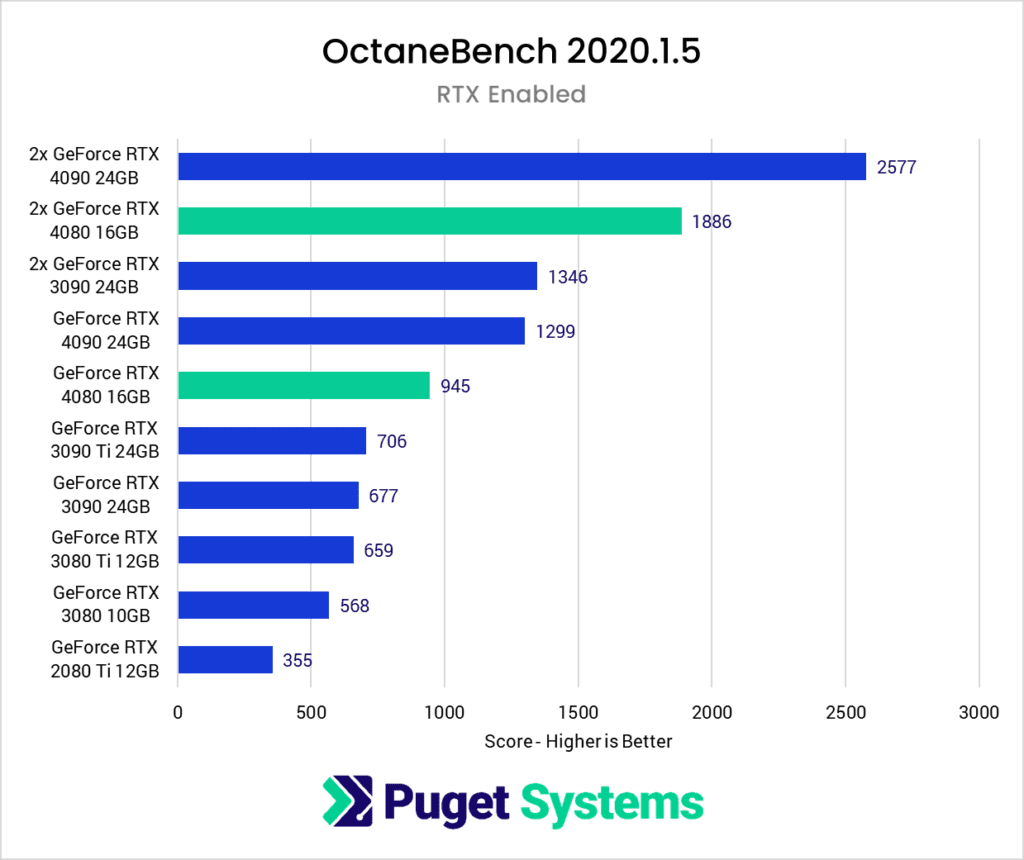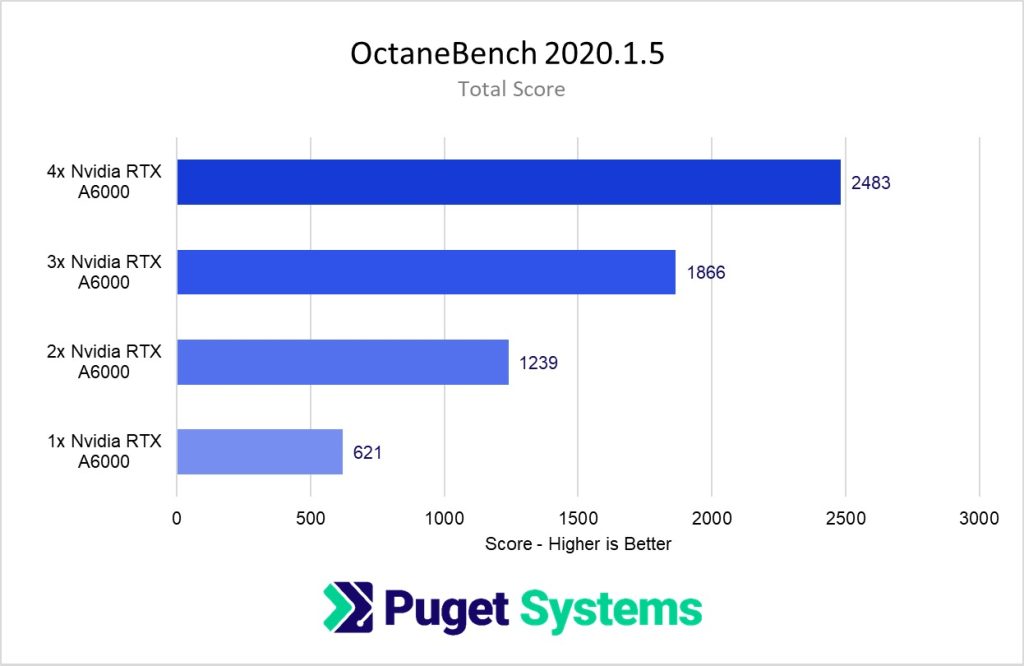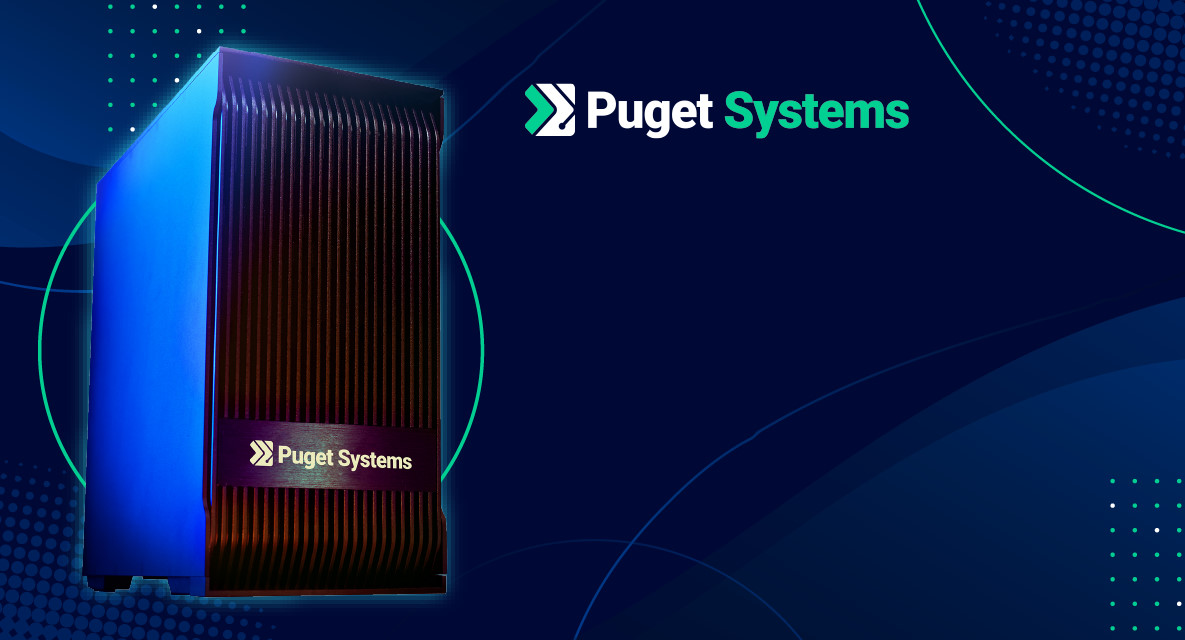
Hardware Recommendations for OctaneRender
We have taken the time here at Puget Systems to test a wide range of video cards to see how well they work in OctaneRender. Based on the results, we have put together the following configuration advice.
Puget Labs Certified
These hardware configurations have been developed and verified through frequent testing by our Labs team. Click here for more details.
OctaneRender System Requirements and Benchmarks
Quickly Jump To: Processor (CPU) • Video Card (GPU) • Memory (RAM) • Storage (Drives) • Network Rendering
Like most applications, the system requirements for OctaneRender can be found on the official OTOY website. It is part of their FAQ page, though, and while it has good info about compatibility it is outdated in terms of performance recommendations. Since their info is outdated, we have taken the time here at Puget Systems to perform our own testing to determine what hardware runs OctaneRender the best. Based on this testing, we have come up with our own list of recommendations.
Is OctaneRender a CPU or GPU based rendering engine?
OctaneRender is a fully GPU-based rendering engine. This means that the video cards (or GPUs) in your system are what impacts how long it takes renders to complete rather than the CPU.
Processor (CPU)
In OctaneRender, as well as most other GPU-based engines, the CPU does not directly play a role in the process of rendering scenes. However, there are calculations that take place in preparation for rendering, between frames in an animation, and the like. For example, OTOY mentions in their FAQ that “a fast multi-core CPU will significantly improve the scene loading speed.”
What type of CPU does OctaneRender need?
Based on our testing, clock speed has the biggest impact on CPU performance with Octane. Core count does not seem to matter at all. This lines up nicely with the CPU requirements of other programs that are frequently used alongside OctaneRender: Maya, 3ds Max, Cinema 4D, and the like all do best with high clock speeds too. If you run other applications besides those, especially any CPU-based rendering engines, then that may change the sort of system you want to get. In such mixed-use cases, please contact our consultants for personalized assistance.
Aside from raw performance, it is also important to consider the number of PCI-Express lanes a CPU supports. This will govern how many video cards can be used, which has a big impact since video cards are the primary driver for rendering performance in Octane.
What is the best CPU for OctaneRender?
As mentioned above, the CPU itself isn’t going to directly contribute to Octane’s rendering – but it will determine how many video cards the system can support, which does impact performance. Here are a couple of our recommendations:
- AMD Ryzen 7 7700X 8 Core – This is one of the highest clock speed CPUs available, and does very well with both OctaneRender and modeling/animation applications. It has enough PCI-Express lanes to support dual video cards, along with other standard hardware devices (NVMe drives, etc).
- AMD Threadripper PRO 7965WX 24 Core – AMD’s Threadripper PRO processors have far more PCI-Express lanes than more consumer-oriented models. Combined with the right motherboard, this CPU can allow up to four video cards in a single tower workstation. The trade-off is that the platform as a whole is more expensive, but being able to fit three or four high-end GPUs in a single system is worthwhile in many workflows.
Will a more powerful CPU help OctaneRender at all?
A faster CPU will sometimes let you open files faster and can make a small difference in multi-frame renders, but it will make no impact on how long it takes each individual render to complete. We recommend sticking with a mid-range CPU and focusing your budget on more powerful GPU(s).
Additional Resources:
Video Card (GPU)
How does OctaneRender utilize video cards (GPUs)?
The video card selection is the driving factor for performance in OctaneRender. There are two aspects of a video card that impact render capabilities: the raw speed of the GPU itself and the amount of memory on the card. Video memory will limit how large and complex of scenes can be rendered GeForce cards tend to have good raw performance, with decent amounts of video memory, while Quadro cards come with larger amounts of VRAM but also cost far more for the same level of raw performance. As such, we recommend GeForce series cards for most Octane users.
What are the best video cards (GPUs) for OctaneRender?
- GeForce RTX 4080 16GB – A great choice if you want just one or two video cards and don’t work with overly complex scenes.
- GeForce RTX 4090 24GB – Our go-to recommendation for most GPU rendering customers, the RTX 4090 provides the best performance in Octane while also having a tremendous 24GB of memory.
- NVIDIA RTX A5000 24GB – For those who want to stack several video cards in the same system, NVIDIA’s professional GPUs are a solid option. The RTX A5000 is the top-end card that can be installed in a set of four in large tower and rackmount chassis within the limits of a 1600W power supply. If you need even more memory, the RTX 6000 Ada Generation has 48GB of VRAM but costs far more and may be limited to two or three GPUs.

Should I use a professional video card for OctaneRender?
It is also important to remember NVIDIA’s professional-grade video cards, as they can be a better choice than GeForce cards for some users. They do cost more, but for that increased price you get several benefits:
- Higher VRAM options – up to 48GB on the RTX A6000 and 6000 Ada
- Better multi-GPU support – thanks to the use of blower-style cooling systems and more constrained power consumption
- ECC memory on higher-end models – for increased stability
Does Octane support multiple GPUs? Do they need to be in SLI?
Unlike most applications that utilize the GPU, OctaneRender actually scales almost perfectly with multiple cards. In other words, if you use two cards your renders will complete twice as fast as they would with just a single GPU. If you use four cards you will finish renders four times faster! However, since Octane is using the cards for compute purposes they do not need to be in SLI mode. In fact, SLI can sometimes cause problems so we recommend leaving it disabled if possible.
For more information on how Octane scales, we recommend reading our OctaneRender Mulit-GPU Scaling article.
How well does OctaneRender scale across multiple video cards (GPUs)?
OctaneRender scales very well across multiple video cards, but the cooling systems on most GeForce models are not designed with multiple GPUs in mind. For the best overall performance, variants with a single fan that exhausts heat out the back (commonly called “blower” cards) are ideal – and most NVIDIA “professional” cards use such cooling systems. Stacking a few of those will give fantastic rendering performance, though it does require a larger chassis, strong power supply, and plenty of airflow from the case fans.

Is it better to spend money on a higher number of total GPUs, or more powerful GPUs, for OctaneRender?
From a pure cost/performance perspective, it is almost always better to use a higher number of more affordable GPUs rather than using one or two expensive GPUs. However, the downside to this approach is that your workstation will be physically larger, louder, hotter, and use more power than a system with fewer but more powerful cards. In addition, if your renders require a higher amount of VRAM (video card memory) you may be forced into using more expensive cards.
Can I mix and match different models of video cards for OctaneRender?
As long as each card is supported, OctaneRender does allow you to mix and match different models of video cards. We do this for some customers who need a primary Quadro video card due to a different software’s hardware requirements, but want to utilize GeForce cards to improve rendering performance in Octane. However, the more different the cards (different architectures, different versions of CUDA, etc.) the larger the chance of errors or other problems occurring. Also note that if the cards have different amounts of VRAM you will be limited to the smallest amount.
Does OctaneRender support all NVIDIA graphics cards?
In general, yes – though when a new generation of video cards comes out it can sometimes take a while before they will work properly. According to OTOY, OctaneRender requires extra work to make it compatible with each new generation of GPUs. For example, NVIDIA released its Volta GPU architecture to consumers in December 2017 with the release of the Titan V – but it did not work with the OctaneRender 3.07, which was the current version at the time. With the release of OctaneRender 3.08, however, Volta support was been added – so it just took a few months after their release for the Titan V and Quadro GV100 graphics cards to be viable in this application.
Do I have to use NVIDIA cards for OctaneRender or can I use AMD?
OctaneRender currently utilizes CUDA which is proprietary to NVIDIA video cards. At the moment, Octane does not support AMD GPUs or Intel integrated graphics.
Recent OctaneRender GPU Articles:
Memory (RAM)
How much memory (RAM) does OctaneRender need?
While the exact amount of RAM you need is going to depend on your particular projects, for OctaneRender (and GPU rendering in general) we generally recommend 32GB at minimum – and often a bit more. Rendering engines like Octane are not usually run all by themselves, so you need to take into account the memory needed for the other programs you have running at the same time. If you are using a 3D modeling program like Cinema 4D, Maya, or 3ds Max then the complexity of your scene will impact how much system memory that software needs in much the same way that it impacts how much VRAM Octane will need on your video card(s).
Storage (Hard Drives)
What is the best type of drive to use for OctaneRender?
Thanks to their speed and relatively affordable price, we strongly recommend solid-state drives (SSDs) for the primary drive that will host your OS and the installation of OctaneRender itself. The high speed of SSDs allows your system to boot, launch applications, and load files many times faster than any traditional hard drive. In particular, the newer NVMe type of SSDs utilize the latest connections like M.2 and offer the fastest transfer rates.
If your budget allows, it is also a very good idea to have a second SSD that can be used to store your active projects to further decrease load and save times. We highly recommend using an OS drive with a capacity of at least 500GB to ensure you do not need to upgrade your primary drive (which is often a complicated process) in the near future.
What sort of drive is best for data storage and backup?
Since SSDs are still more expensive than platter drives per GB, for long-term storage and backup we recommend using a traditional hard drive or even an external drive array. Network attached storage systems are a great way to go for that, as they can be shared between multiple workstations and usually offer features to provide some level of data redundancy (protection against losing files if one of the drives dies).
Network Rendering
How does Network Rendering work in OctaneRender? Do I need special licenses?
Network Rendering allows you to use the power of GPUs that are in other workstations or servers on your network to make your renders complete faster than you could ever achieve on a single system. All you need is a standalone license for each slave machine that is the same version as what you are using on your local master workstation. For more information on Network Rendering we recommend reading OTOY’s excellent documentation of the subject in their Manual under the “Network Rendering” section. Glass Hand Studios also has an excellent Youtube video showing how to install and configure Network Rendering if you want to see the process in action.
Note that Network Render is currently limited to a total of 20 GPUs and requires at least one compatible GPU in your local machine.
Can I use Linux on an OctaneRender Network Render node even if I use Windows on my main workstation?
From the OctaneRender manual: “The operating systems of the slaves can also be different since the communication between the machines is cross platform.” In other words: yes, you should be able to mix Windows and Linux without any problems.



